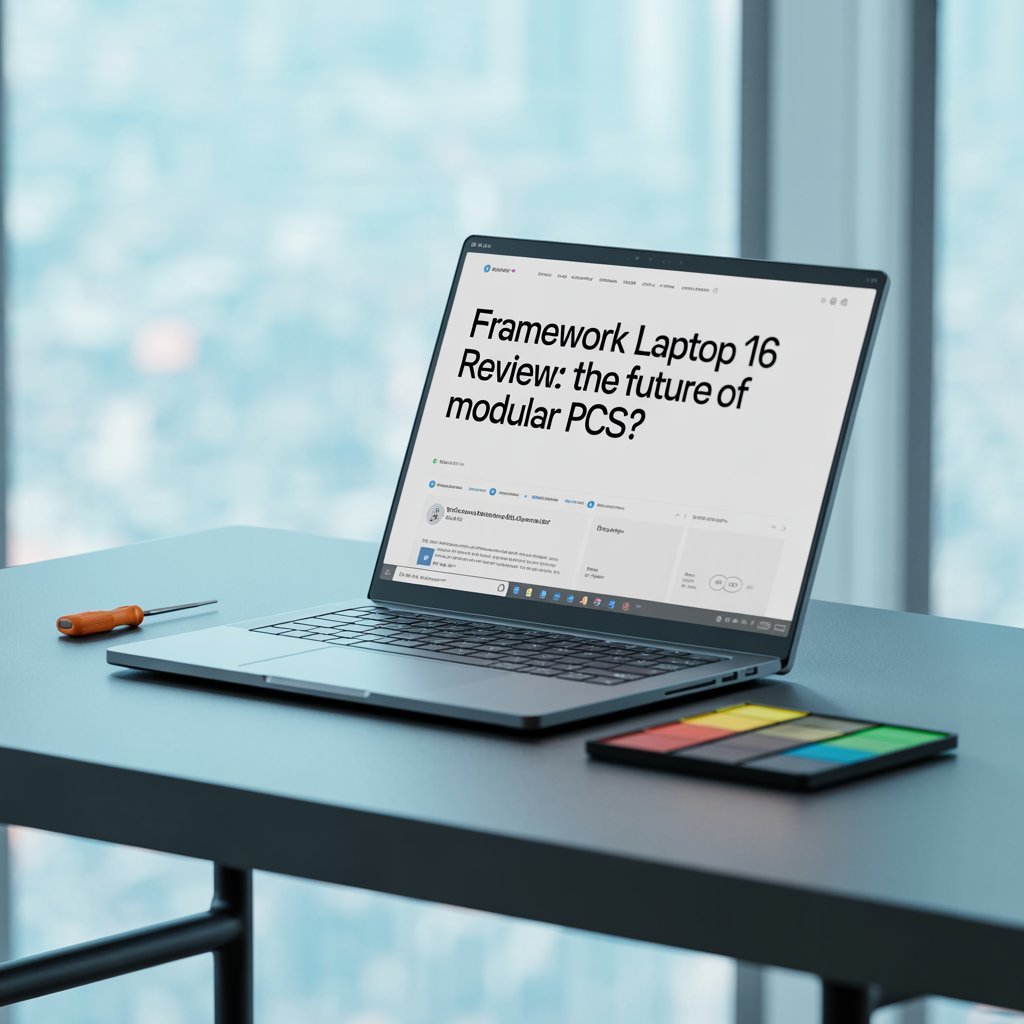Introduction
The laptop industry has long been dominated by sealed, disposable devices. Most manufacturers prioritize thinness and cost over repairability, leaving consumers with few options when a single component fails. Enter the Framework Laptop 16, a bold attempt to redefine what a laptop can be modular, upgradeable, and sustainable.
Framework, the company behind the well-received Framework Laptop 13, has taken its mission further with the 16-inch model, featuring an even more ambitious modular design. With swappable GPUs, customizable input modules, and easy-access internals, it promises a future where users, not corporations, control their devices’ lifespan.
But does it deliver? Is this truly the future of PCs, or just a niche product for tinkerers? In this in-depth review, we’ll examine:
Design & Build Quality – Does it feel premium, or does modularity compromise durability?
Modularity & Upgradability – How easy is it to swap parts? What are the limits?
Performance & Benchmarks – Can it compete with traditional laptops?
Software & Ecosystem – How does Framework support its hardware long-term?
The Big Question – Is this the blueprint for future laptops, or just a clever experiment?
Let’s dive in.
1. Design & Build Quality
First Impressions: A Modular Laptop That Doesn’t Look Like One
Unlike DIY projects that scream “prototype,” the Framework Laptop 16 looks surprisingly polished. Its aluminum chassis feels premium, closer to a MacBook Pro or Dell XPS than a hackable dev kit. The matte black finish (with optional silver) resists fingerprints, and the 16-inch 16:10 display offers ample screen real estate without feeling bulky.
Keyboard & Trackpad: Customizable Inputs
Magnetic Modular Keyboard – Keys can be swapped for different layouts (QWERTY, AZERTY, etc.) or even replaced with blank keycaps for customization.
Haptic Touchpad – Smooth and responsive, competing with Apple’s Force Touch.
Removable NumPad Module – A clever add-on for number-crunchers that slots into the touchpad area.
Ports: The Expansion Bay System
Instead of fixed ports, the laptop uses hot-swappable Expansion Cards:
Default options: USB-C, USB-A, HDMI, DisplayPort, microSD, and even a 3.5mm audio jack.
Future-proofing: Framework promises more modules (e.g., Ethernet, external GPU enclosures).
Display: Good, But Not Best-in-Class
2560×1600 IPS panel – Sharp and color-accurate (100% sRGB), but not OLED.
165Hz refresh rate – Great for gaming, but battery life takes a hit.
Modular bezels – Unique feature: The webcam and bezel can be replaced without tools.
Weight & Thickness: The Trade-Off
At 4.6 lbs (2.1 kg), it’s heavier than a MacBook Pro 16″ (4.7 lbs) but thinner than most gaming laptops. The modular design adds some bulk, but not excessively.
Verdict: Framework nailed the balance between modularity and premium feel. It doesn’t scream “experiment,” yet offers unparalleled customization.
2. Modularity & Upgradability
The Expansion Bay: Swappable GPU & Storage
The biggest innovation is the rear Expansion Bay, allowing for:
Discrete GPU upgrades – Currently, AMD Radeon RX 7700S (with more options coming).
Additional storage/NVMe slots – No need to replace your main SSD; just add another.
Extra battery or cooling modules – Future potential for specialized use cases.
RAM, SSD, & Wi-Fi: No Soldered Nonsense
Unlike most modern laptops:
DDR5 SODIMM slots – Upgrade up to 64GB RAM.
Two NVMe slots – No proprietary connectors; use any Gen4 SSD.
Replaceable Wi-Fi card – Fix or upgrade without replacing the whole motherboard.
Real-World Upgrade Experience
Tools included – Framework provides a screwdriver and guides for every step.
No glue, no clips – Just screws and connectors.
Average user can upgrade in minutes – Far easier than older modular projects like the ThinkPad T series.
The Framework Marketplace & Third-Party Support
Official store sells modules (new keyboards, bezels, GPUs).
Community-driven mods – 3D-printed parts, custom input modules.
Linux compatibility – A major win for developers and open-source enthusiasts.
Verdict: This is the most upgradeable laptop ever made. If other companies follow, e-waste could plummet.
3. Performance & Benchmarks
CPU: AMD Ryzen 7040 Series Shines
Ryzen 7 7840HS (8-core/16-thread) performs near a MacBook Pro M2 in multi-core.
Efficient power use – Better battery life than Intel equivalents.
GPU: Discrete, But Not a Gaming Beast
Radeon RX 7700S – Beats integrated graphics but trails behind RTX 4060 laptops.
Good for 1080p gaming – Not a desktop replacement, but decent for casual gamers.
Thermals & Noise
Dual-fan system keeps temps in check.
Audible under load, but quieter than most gaming laptops.
Battery Life
6–8 hours (normal use) – Better than gaming laptops, worse than ultrabooks.
Modular trade-off – Extra GPU drains battery faster.
Verdict: It’s fast, but not the fastest. The focus is on flexibility, not raw power.
4. Software & Ecosystem
Framework’s Firmware Approach
Open BIOS updates – No forced obsolescence.
Linux-friendly – Ubuntu and Fedora work flawlessly.
Long-Term Support Promise
– Framework commits to 5+ years of parts availability.
– No planned obsolescence – A direct challenge to Apple and Dell.
5. Pros & Cons
Pros
Unmatched upgradeability – Fix, replace, or upgrade anything.
Eco-friendly – Reduces e-waste dramatically.
Linux & developer-friendly – No driver headaches.
Premium build – Doesn’t feel like a DIY project.
Cons
Expensive upfront – Cheaper than a MacBook Pro 16″, but still premium.
GPU not top-tier – Not for hardcore gamers.
Battery life is just okay – Modularity has trade-offs.
Conclusion: Is This the Future?
The Framework Laptop 16 isn’t perfect, but it’s the most important laptop in years. It proves that modular, repairable, and upgradeable designs can work without sacrificing quality.
Who Should Buy It?
Tech enthusiasts who want control over their hardware.
Developers & Linux user tired of locked-down systems.
Eco-conscious buyers who hate disposable tech.
Who Should Skip It?
Gamers needing max GPU power.
Average users who just want a simple, no-fuss laptop.
Final Verdict
Framework has built something revolutionary. If the industry follows, we could see a real shift away from throwaway electronics. For now, it’s a fantastic niche product and hopefully, a sign of what’s to come.
Would you buy one? Let us know in the comments!





